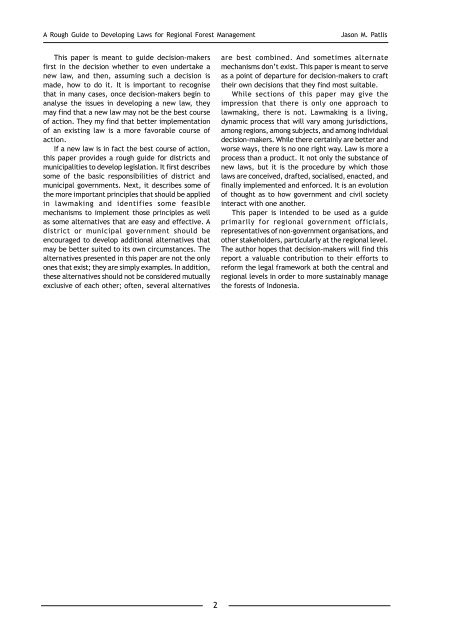A rough guide to developing laws for regional forest management
A rough guide to developing laws for regional forest management
A rough guide to developing laws for regional forest management
Create successful ePaper yourself
Turn your PDF publications into a flip-book with our unique Google optimized e-Paper software.
A Rough Guide <strong>to</strong> Developing Laws <strong>for</strong> Regional Forest Management<br />
Jason M. Patlis<br />
This paper is meant <strong>to</strong> <strong>guide</strong> decision-makers<br />
first in the decision whether <strong>to</strong> even undertake a<br />
new law, and then, assuming such a decision is<br />
made, how <strong>to</strong> do it. It is important <strong>to</strong> recognise<br />
that in many cases, once decision-makers begin <strong>to</strong><br />
analyse the issues in <strong>developing</strong> a new law, they<br />
may find that a new law may not be the best course<br />
of action. They my find that better implementation<br />
of an existing law is a more favorable course of<br />
action.<br />
If a new law is in fact the best course of action,<br />
this paper provides a <strong>rough</strong> <strong>guide</strong> <strong>for</strong> districts and<br />
municipalities <strong>to</strong> develop legislation. It first describes<br />
some of the basic responsibilities of district and<br />
municipal governments. Next, it describes some of<br />
the more important principles that should be applied<br />
in lawmaking and identifies some feasible<br />
mechanisms <strong>to</strong> implement those principles as well<br />
as some alternatives that are easy and effective. A<br />
district or municipal government should be<br />
encouraged <strong>to</strong> develop additional alternatives that<br />
may be better suited <strong>to</strong> its own circumstances. The<br />
alternatives presented in this paper are not the only<br />
ones that exist; they are simply examples. In addition,<br />
these alternatives should not be considered mutually<br />
exclusive of each other; often, several alternatives<br />
are best combined. And sometimes alternate<br />
mechanisms don’t exist. This paper is meant <strong>to</strong> serve<br />
as a point of departure <strong>for</strong> decision-makers <strong>to</strong> craft<br />
their own decisions that they find most suitable.<br />
While sections of this paper may give the<br />
impression that there is only one approach <strong>to</strong><br />
lawmaking, there is not. Lawmaking is a living,<br />
dynamic process that will vary among jurisdictions,<br />
among regions, among subjects, and among individual<br />
decision-makers. While there certainly are better and<br />
worse ways, there is no one right way. Law is more a<br />
process than a product. It not only the substance of<br />
new <strong>laws</strong>, but it is the procedure by which those<br />
<strong>laws</strong> are conceived, drafted, socialised, enacted, and<br />
finally implemented and en<strong>for</strong>ced. It is an evolution<br />
of thought as <strong>to</strong> how government and civil society<br />
interact with one another.<br />
This paper is intended <strong>to</strong> be used as a <strong>guide</strong><br />
primarily <strong>for</strong> <strong>regional</strong> government officials,<br />
representatives of non-government organisations, and<br />
other stakeholders, particularly at the <strong>regional</strong> level.<br />
The author hopes that decision-makers will find this<br />
report a valuable contribution <strong>to</strong> their ef<strong>for</strong>ts <strong>to</strong><br />
re<strong>for</strong>m the legal framework at both the central and<br />
<strong>regional</strong> levels in order <strong>to</strong> more sustainably manage<br />
the <strong>for</strong>ests of Indonesia.<br />
2

















